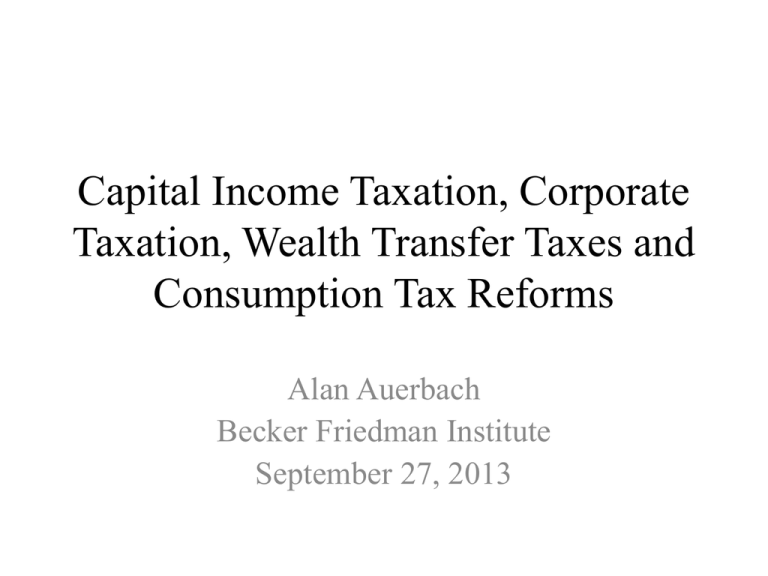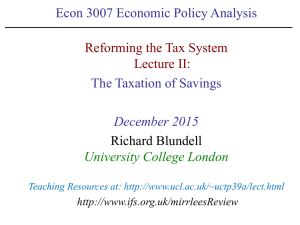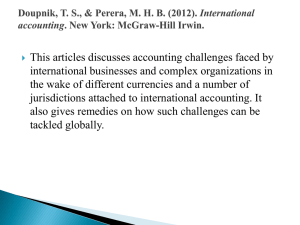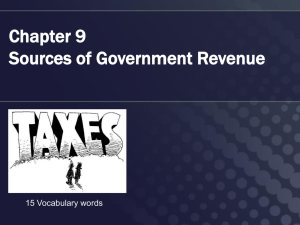Capital Income Taxation, Corporate Taxation, Wealth Transfer Taxes
advertisement

Capital Income Taxation, Corporate Taxation, Wealth Transfer Taxes and Consumption Tax Reforms Alan Auerbach Becker Friedman Institute September 27, 2013 Outline • The Choice between Income and Consumption Taxes • Corporate Taxation • Wealth Transfer Taxes Income vs. Consumption Taxes • Tax Wedges, Timing, and the Components of Capital Income • Equity, Efficiency and the New Dynamic Public Finance • Tax Salience, Inertia, Self-Control and Targeted Saving Tax Wedges, Timing, and the Components of Capital Income • Atkinson-Stiglitz (1976) and Chamley (1986)/ Judd (1985): two different rationales for avoiding capital income taxes – Not helpful vs. very distortionary • But many additional, subtle points to consider, regarding timing and what capital income is Timing • Dynamic inconsistency – How much of an issue, in practice (TRA86 example) • Labor income taxes vs. consumption taxes – Differ “only” in transition but can represent the difference between efficiency gains and efficiency losses (Auerbach, Kotlikoff, Skinner 1983) – Intertemporal elasticity of substitution less crucial a parameter than in simple models Components of Capital Income • Safe return to capital vs. other components – Quasi-rents to old capital – Rents – Disguised labor income – Compensation for risk • Consumption tax (EET) hits these, labor income tax (TEE) does not – Third alternative emphasized in Mirrlees Review: TtE; makes clear role of safe return Components of Capital Income • How much of a difference does a tax on the safe return to capital make? – May be other reasons for taxing it, for example to substitute for age-based variations in tax schedules • For other components, different factors matter – Flexibility of converting labor to capital income – Efficiency of risk-pooling in private markets – Mobility of rents New Dynamic Public Finance • Another reason to tax capital income: to relax self-selection constraints in dynamic optimal income tax setting • Implications for capital income tax rates not clear, since results relate to tax wedge – Can be consistent with zero average tax rates – Relates to “the” return to capital, not other components of reported capital income Tax Salience, Inertia, Self-Control and Targeted Saving • Saving is an area of focus in behavioral economics – Requires long-term planning and delayed gratification – Trade-offs may be difficult to understand – Limited opportunity for learning Issues and Implications • With self-control problems, may want to subsidize saving; but may not – Offsetting aversion to saving vs. facilitating meltdowns • With excessive discounting, timing of tax payments may matter – another distinction between TEE and EET Issues and Implications • Employers and organized activity may be critical – Saving could actually be discouraged by more general favorable tax treatment • Are targeted saving schemes a good idea? – Tax arbitrage vs. mental accounts; conflicting evidence Summary, So Far • Capital income is different from labor income • Tax rate on the normal return to capital is a small part of the issue of how to tax capital income • Conclusions depend critically on how saving decisions are made Corporate Taxation • A lot since Harberger! – Developments in theory and evidence – Also, a changing economic environment Theory and Evidence • As before, components of capital income matter • Sources of finance – Debt vs. equity finance – Retained earnings vs. new shares • Dividend tax capitalization and the vanishing Harberger triangle – A marginal tax on new equity rather than on all corporate capital? Theory and Evidence • As before, components of capital income matter • New vs. old capital – With investment incentives, the same distinction as TEE vs. EET Theory and Evidence • Consistent evidence of responsiveness to taxation, but implications for tax policy not always clear • Strong cross-section responsiveness to investment incentives – Less evidence on aggregate responsiveness – Relevance of liquidity constraints not clear – Timing of policy interventions very predictable Theory and Evidence • Consistent evidence of responsiveness to taxation, but implications for tax policy not always clear • Dividend policy responds to taxation – Could be a timing response – Evidence of agency effects Theory and Evidence • Consistent evidence of responsiveness to taxation, but implications for tax policy not always clear • Borrowing responds to tax advantage – But, again, may be limited by agency considerations Tax Policy and Agency Problems • Dividend tax may exacerbate agency problem – Encouraging managers to overinvest – But, if so, why not raise the corporate tax? • Managers may borrow to little for shareholder wealth maximization – But this may help offset the underlying tax distortion between debt and equity Changing Economic Environment • The fall of the corporation – Only half of business income now in traditional corporate form • The rise of the multinational corporation – Most corporate assets now in multinationals • Implications for corporate tax incidence, distortions and design – Additional margins of response to consider Taxing Multinational Corporations • With cross-border capital mobility, another argument against capital income taxation – Some evidence of shifts to labor, but econometric challenges in using cross-country data • Capital is not all that moves – Financial and accounting adjustments to take advantage of tax differentials – Another cause for thinking about different components of capital income Taxing Multinational Corporations • Hard to know what optimal tax system is, with so many margins of responsiveness • Another complication: tax competition – How will other countries react (or cooperate)? Taxing Multinational Corporations • Typically, think about combinations of tax on three components of income – Domestic earnings of domestic corporations – Domestic earnings of foreign corporations – Foreign earnings of domestic corporations – Existing systems choose 2 of 3, based on source or residence, but obvious problems with both • Relative immobility of consumers represents an added argument for consumption-based taxation Wealth Transfer Taxes • In some respects, equivalent to capital income taxation; but important differences: – Difficulties in administering taxes on wealth transfers – Uncertain lifetimes – annuity effect – Different individuals involved – Role in intergenerational persistence of inequality Administering Wealth Transfer Taxes • Infrequent taxation facilitates tax planning • Should integrate with inter vivos transfers, which may be hard to observe • Clear evidence of responsiveness to estate tax rates, but also that tax planning falls short of rational optimization Optimal Wealth Transfer Taxes • Is the optimal tax a subsidy? – How to take account of different generations in measuring social welfare – Can be progressive without being positive (FarhiWerning, 2010) – May want to tax, for the same logic as in NDPF (Kopcuzk, 2013) Optimal Wealth Transfer Taxes • Bequest motive matters – Accidental bequests vs. warm-glow vs. altruistic • Correlation of ability matters – Can generate large optimal top tax rates (PikettySaez, 2013) – Also an argument for taxing inheritances vs. bequests Optimal Wealth Transfer Taxes • As yet, a lack of integration of theory, evidence on responsiveness and issues of administration Conclusions • Capital income is different than labor income, so no obvious reason to think of income taxation as a logical objective • Capital income has different components, and should think about how to tax these components differently • The intertemporal consumption decision is one of many that are relevant to optimal tax rate Conclusions • Administration and enforcement need to be integrated in tax design, particularly in considering taxes on multinational corporations and wealth transfers • Decision-making and agency considerations relevant, in some cases central • Notions of optimality are also more difficult once other generations and the responses of other countries come into play











